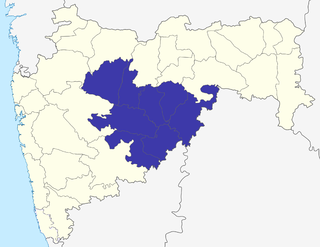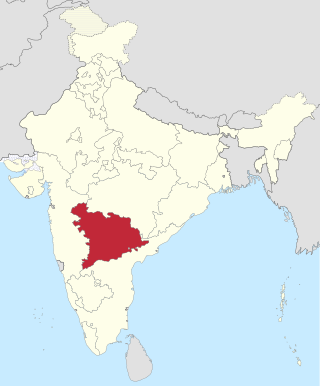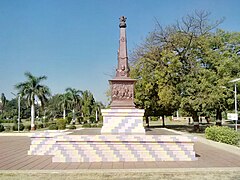
Hyderabad State or Hyderabad Deccan was a kingdom, country, and princely state in the Deccan with its capital at the city of Hyderabad. It is now divided into the state of Telangana, the Kalyana-Karnataka region of Karnataka, and the Marathwada region of Maharashtra in present-day India, which annexed it in 1948.
Desh is a region adjacent to the Western Ghats between the Godavari River and Krishna River, a part of Deccan Plateau, in the states of Maharashtra, Karnataka, and Andhra Pradesh. The region is hilly and slopes towards the east, and is drained by the upper reaches of the Godavari and Krishna rivers and their tributaries.

Marathwada is a proposed state and geographical region of the Indian state of Maharashtra. It was formed during the Nizam's rule and was part of the then Hyderabad State. The region coincides with the Aurangabad division of Maharashtra. It borders the states of Karnataka and Telangana, and it lies to the west of the Vidarbha and east of Uttar Maharashtra regions of Maharashtra. The largest city of Marathwada is Aurangabad. Its people speak Marathi and Deccani Urdu.

The princely state of Hyderabad was annexed by India in September 1948 through a military operation code-named Operation Polo, which was dubbed a "police action".

Nizam of Hyderabad was the title of the ruler of Hyderabad State. Nizam is a shortened form of Niẓām ul-Mulk, which means Administrator of the Realm, and was the title bestowed upon Asaf Jah I when he was appointed Viceroy of the Deccan by the Mughal Emperor Farrukhsiyar. In addition to being the Mughal Viceroy (Naib) of the Deccan, Asaf Jah I was also the premier courtier of the Mughal Empire until 1724, when he established the independent monarchy of Hyderabad and adopted the title "Nizam of Hyderabad".

Nanded is a city in Maharashtra state, India. It is the tenth largest city in the state and the seventy-ninth most populated city in India. It is the second largest city in Marathwada region. It is the district headquarters of Nanded district.

State Bank of Hyderabad (SBH) was a regional bank in Hyderabad, with headquarters at Gunfoundry, Abids, Hyderabad, Telangana. Founded by the 7th Nizam of Hyderabad State, Mir Osman Ali Khan, it is now one of the five associate banks of State Bank of India (SBI) and was one of the nationalised banks in India. It was established on 8 February 1941 as the Hyderabad State Bank. From 1956 until 31 March 2017, it had been an associate bank of the SBI, the largest such. After formation of Telangana in 2014, SBH was the lead bank of the newly created state. The State Bank of Hyderabad was merged with State Bank of India on 1 April 2017.

Mir Osman Ali Khan, Asaf Jah VII was the last Nizam (ruler) of the Princely State of Hyderabad, the largest state in the British Indian Empire. He ascended the throne on 29 August 1911, at the age of 25 and ruled the State of Hyderabad between 1911 and 1948, until India annexed it. He was styled as His Exalted Highness (H.E.H) the Nizam of Hyderabad, and was widely considered one of the world's wealthiest people of all time. With some estimates placing his wealth at 2% of U.S. GDP, his portrait was on the cover of Time magazine in 1937. As a semi-autonomous monarch, he had his mint, printing his currency, the Hyderabadi rupee, and had a private treasury that was said to contain £100 million in gold and silver bullion, and a further £400 million of jewels. The major source of his wealth was the Golconda mines, the only supplier of diamonds in the world at that time. Among them was the Jacob Diamond, valued at some £50 million, and used by the Nizam as a paperweight.

Hyderabadi Muslims, also referred to as Hyderabadis, are a community of Deccani people, from the area that used to be the princely state of Hyderabad in the regions of Marathwada, Telangana, and Kalyana-Karnataka.

Kasim Razvi was a politician in the princely state of Hyderabad. He was the president of the Majlis-e-Ittehadul Muslimeen party from December 1946 until the state's Annexation in 1948. He was also the founder of the Razakar militia in the state. He held the levers of power with the Nizam of Hyderabad, blocking the possibilities of his accommodation with the Dominion of India.

The Razakars were a paramilitary volunteer force and homeguard in Hyderabad State whose goals were to defend the state against an Indian invasion. Formed in 1938 by the MIM leader Bahadur Yar Jung, the organisation expanded considerably during the leadership of Qasim Razvi by the time of India's annexation of the country. Although primarily associated with the Muslim political party Majlis-e-Ittehadul Muslimeen (MIM), it quickly began to draw Dalits and other Hyderabadi Hindus into its ranks, in addition to later collaborating with the communists in 1948.
Hyderabad-Karnataka Liberation Day, officially known as, Kalyana-Karnataka Liberation Day is an annual festival celebrated in seven districts like Bidar district, Kalaburagi district, Yadgir district, Raichur district, Ballari district & Koppal district, Vijayanagara district of Karnataka state, India. It takes place on 17 September. The festival celebrates the annexation of Hyderabad by India in 1948 following the Partition of India and rebellions in Hyderabad State.
Rao Bahadur Pemmanda K. Monnappa was a police officer of South India. He served in three Southern states, Madras, Hyderabad and Mysore (Karnataka), at different times. However, he is to be best remembered for his contributions towards the integration of Hyderabad into the Union. Monnappa had a career in the Public Service reflected by his titles and medals.

Maa Bhoomi is a 1979 Indian Telugu-language social problem film directed by Goutam Ghose in his debut. The film is produced by B. Narsing Rao, who also wrote the film with Goutam Ghose. The film is based on the novel Jab Khet Jage by Krishan Chander on the Telangana Rebellion in Hyderabad State. It depicts a typical life of villagers under feudalistic society in the Telangana region. The film features Sai Chand, Rami Reddy and Telangana Shakuntala in pivotal roles. The plot follows Ramayya, a landless peasant who joins the Telangana Rebellion of 1948.
The Hyderabad State Congress was a political party in the princely state of Hyderabad that sought civil rights, representative democracy and the union of Hyderabad with the Republic of India. It opposed the autocratic rule of the Nizam of Hyderabad and the militancy of the Razakars. HSC was formed in 1938.

Hyderabad State was a state in Dominion and later Republic of India, formed after the accession of the State of Hyderabad into the Union on 17 September 1948. It existed from 1948 to 1956. Hyderabad State comprised present day Telangana, Marathwada and Hyderabad-Karnataka

Kalyana-Karnataka, formerly known as Hyderabad-Karnataka, is a region located in the northern part of the Indian state of Karnataka, which was part of Kingdom of Hyderabad ruled by the Nizams and the Madras presidency of British India. The region comprises Bidar, Yadgir, Raichur, Koppal and Kalaburagi of Hyderabad state and, Ballari and Vijayanagara of the Madras province that are now present in the state of Karnataka. The Northeast-Karnataka region is the second largest arid region in India. Kalaburagi and Ballari are the largest cities of this region.

The history of Telangana, located on the high Deccan Plateau, includes its being ruled by the Satavahana Dynasty, the Kakatiya Dynasty (1083–1323), the Musunuri Nayaks (1326–1356), the Delhi Sultanate, the Bahmani Sultanate (1347–1512), Golconda Sultanate (1512–1687) and Asaf Jahi dynasty (1724–1950).
The Parkala Massacre was the killing of 22 Protestors on 2 September 1947, by the Razakars in the town of Parkala. The massacre suppressed the popular movement for India to annex the Hyderabad State.

Razakar, also marketed as Razakar: The Silent Genocide Of Hyderabad, is a 2024 Indian Telugu-language epic historical action drama film written and directed by Yata Satyanarayana based on the events leading to Operation Polo in the erstwhile Princely state of Hyderabad. The film is produced by Gudur Narayana Reddy, under Samarveer Creation LLP. It was released on 15 March 2024.















